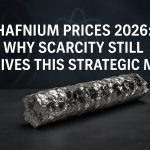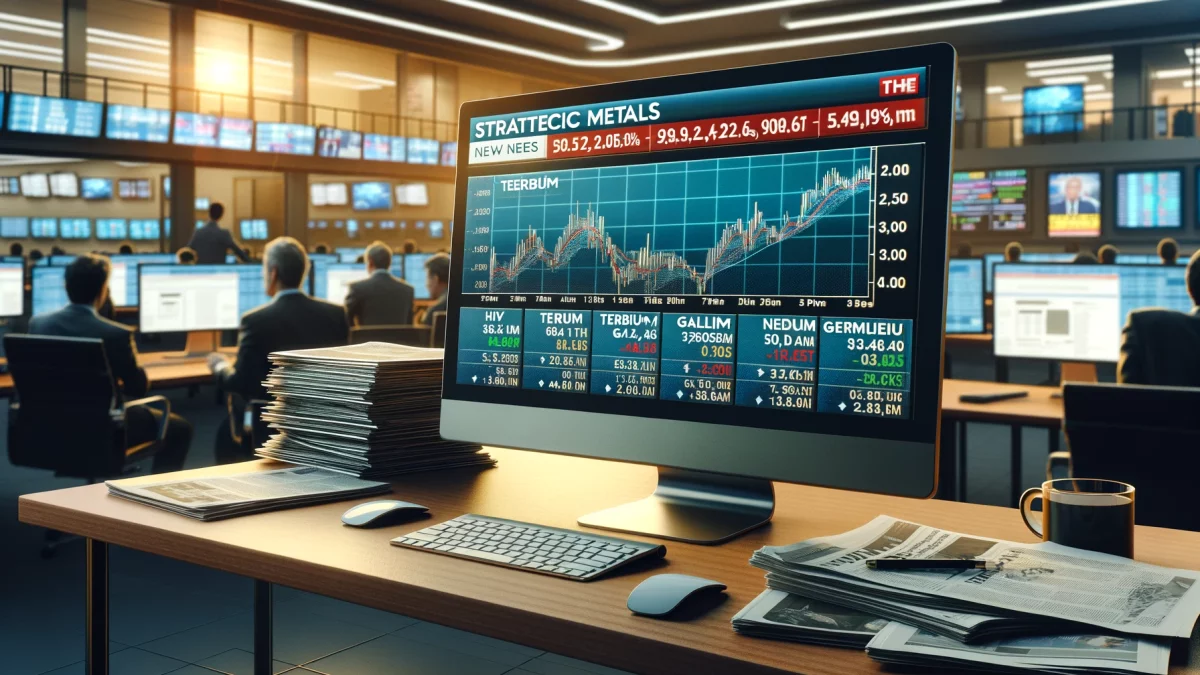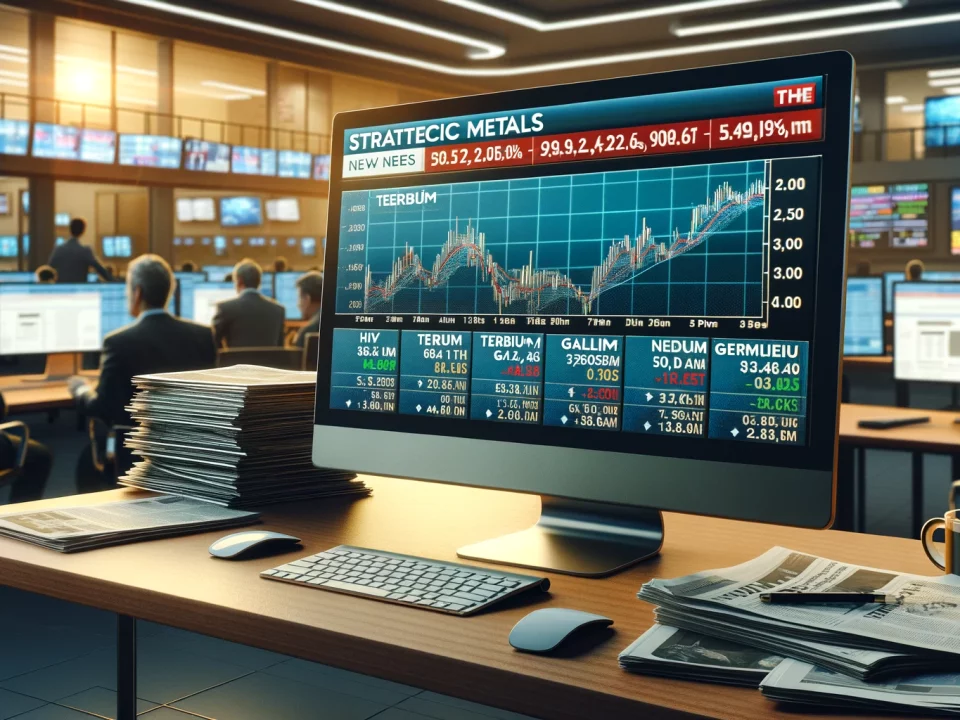
Weekly News Review September 1 – September 7 2025
September 7, 2025
Hafnium Prices 2025: Why Scarcity Still Drives This Strategic Metal
September 16, 2025This week, global developments in the critical minerals sector highlight adjustments to the supply chain, government investment, and ongoing production challenges. China’s rare earth exports fell slightly in August, while the U.S. Department of Defense and DOE continue to back domestic initiatives in critical minerals and gallium production. Strategic alliances and new permits further underscore global efforts to secure supply chains for key metals.
All this and more from the editorial team at rawmaterials.net, our media partner on the industry side.
CHINA: RARE EARTH EXPORTS DIP IN AUGUST:
China’s exports of rare earths fell slightly in August, according to the latest figures from the country’s customs authorities. At around 5,792 tons, this represents a decline of 3.4 percent compared with July 2025.
However, the level remains significantly higher than it was in the same month last year. Detailed information on the development of rare earth exports, broken down by individual product groups, will be released by the authorities later this month.
Since April this year, restrictions have been in place on the export of certain rare earths from China, the global market leader in this sector.
GERMANY: SOLAR POWER OVERTAKES NATURAL GAS IN ELECTRICITY GENERATION –
In the first half of 2025, overall electricity generation from renewable sources in Germany declined.
According to the latest figures from the German Federal Statistical Office (Destatis), power generation from renewables fell by 5.9 percent compared with the same period last year. Nonetheless, renewables still accounted for 57.8 percent of total domestic electricity production.
By contrast, electricity from conventional energy sources rose by 10.1 percent year-on-year, making up 42.2 percent of total generation.
Wind power remained the single most important source of electricity at 27.2 percent. However, due to unusually weak wind conditions, wind generation in the first half of 2025 dropped by 18.1 percent compared with the previous year.
Solar power, on the other hand, recorded a sharp increase of 27.9 percent, driven by new installations and many hours of sunshine. As a result, solar energy has now moved into third place among Germany’s power sources, surpassing natural gas. Coal remains in second place.
Calls for a Faster Energy Transition – Raw Material Needs in Focus:
Although the share of renewable electricity in Germany continues to grow, organizations such as the German Energy Agency (dena) and the Federal Audit Office have repeatedly called for a faster pace in the energy transition. They argue this is necessary both to meet climate targets and to maintain competitiveness.
In addition to slow permitting processes and outdated power grids, the growing demand for raw materials and Germany’s dependence on China for them is seen as a significant challenge, particularly in wind energy. About a month ago, industry representatives and the Federal Ministry for Economic Affairs and Energy presented an action plan aimed at reducing reliance on permanent magnets made from rare earth elements, which are crucial components, especially for offshore wind turbines.
UNITED STATES: STRATEGIC METALS INKS USD $500 MILLION DEAL IN PAKISTAN –
The Asian country is rich in mineral resources, but the sector remains underdeveloped so far.
Missouri-based U.S. Strategic Metals (USSM) has signed a $500 million Memorandum of Understanding with Pakistan’s Frontier Works Organization to develop a poly-metallic refinery in Pakistan and export antimony, copper, gold, tungsten, and rare earth elements.
The agreement was announced after a U.S. business delegation met with Prime Minister Shehbaz Sharif in Islamabad. A parallel MoU links Pakistan’s National Logistics Corp with Portugal-based Mota-Engil for infrastructure and logistics support.
Next steps include evaluating Pakistan’s mineral potential and expanding cooperation across the value chain. The deal follows last month’s U.S.–Pakistan trade agreement, which reduced tariffs and opened the door to joint energy development. Earlier, an April meeting between U.S. Secretary of State Marco Rubio and Foreign Minister Ishaq Dar signaled future collaboration in mining and critical minerals.
While Pakistan’s mineral wealth is valued at up to $6 trillion, analysts caution that much remains untapped and underdeveloped, hindered by outdated infrastructure, limited geological data, and investor uncertainty. To address these problems, Pakistan published the National Minerals Harmonisation Framework 2025 with the primary goal of streamlining geological data and attracting international investment.
WORLD PLATINUM COUNCIL HIGHLIGHTS ONGOING SUPPLY CONSTRAINTS:
Higher jewelry and investment demand, as well as mining disruptions, offset a decline in the glass and automotive sectors.
The global platinum market is set for its third consecutive annual deficit in 2025, according to the latest quarterly outlook from the World Platinum Investment Council (WPIC). While the projected shortfall has been revised down from earlier estimates, the deficit is still expected to reach 850,000 ounces, or 26.44 metric tons, equal to roughly 12 percent of the total estimated supply for the year.
On the supply side, mining output fell eight percent year-on-year in the second quarter. However, it rebounded strongly from the first quarter, which was disrupted by heavy rainfall and operational issues in South Africa, the world’s primary supplier. Full-year mining production is forecast to decline six percent to its lowest level in five years. As a result, total supply in 2025 is expected to fall by three percent.
Jewelry and Investment Inflow Balance Out a Demand Drop in the Glass and Automotive Sectors:
Demand, meanwhile, has proven resilient. Jewelry consumption surged 32 percent year-on-year in the second quarter, led by a 42 percent jump in China. Global investment demand is also up this year, despite temporary outflows from exchange stocks earlier in the year. Lease rates for physical platinum have continuously climbed throughout the year, reflecting a tightening market.
However, automotive demand is expected to contract, reflecting tariff uncertainty and weaker vehicle production, according to the WPIC. Industrial usage is forecast to decline 22 percent, primarily driven by a collapse in glass sector demand, though growth continues in hydrogen, petroleum, and medical applications.
Prices have responded decisively to these conditions over the first half of the year. Platinum reached a ten-year high in June, making it the best-performing commodity in the first half of the year.
“The entire precious metals sector is experiencing massive upward momentum, with gold and silver reaching one record level after another. Gold just broke the important €100 per gram mark yesterday, while silver hovers above its 14-year high. Platinum and the platinum-group-metal sector as a whole are no exception, especially the high lease rates highlight the tight supply situation,” said Philipp Goetzl-Mamba, precious metals trader from German-based TRADIUM GmbH.
UNITED STATES: MINE TO MAGNET WITHOUT CHINA – BREAKTHROUGH ANNOUNCED.
Rare earth products, mined and refined in the United States, have qualified to be manufactured into permanent magnets.
U.S. uranium and rare earth producer Energy Fuels and South Korea’s Posco, which announced a partnership in March, aim to reduce reliance on China for electric motor components. The companies have now confirmed that neodymium-praseodymium (NdPr) produced by Energy Fuels meets all quality standards and is already being used at an industrial scale in Posco’s permanent magnet production. Energy Fuels describes this as a “critical breakthrough” in creating a mine-to-magnet supply chain.
The raw materials come from monazite concentrates mined in Florida and Georgia by the chemical company Chemours. Energy Fuels processes the concentrates at its White Mesa Mill in Utah, currently the only facility in North America capable of producing rare earth oxides from monazite. Magnets produced by Posco from this NdPr are intended for electric and hybrid vehicles in North America, the EU, Japan, and Korea. According to Energy Fuels, the initial shipment of NdPr delivered earlier this year could power approximately 1,500 new electric and hybrid vehicles. The two companies are now negotiating a long-term supply agreement.
In addition, Energy Fuels began producing heavy rare earths in July, a sector even more dominated by China than lighter rare earths like neodymium. Since April, most heavy rare earths have been subject to export controls by China, further straining global supply. Other Western producers are also accelerating efforts to establish independent supply chains for these critical materials.
UNITED STATES: PENTAGON INVESTS IN RARE EARTH DOMESTIC REFINING –
ReElement Technologies has received funding to expand the downstream segment of the critical minerals value chain.
The U.S. Department of Defense is supporting domestic critical materials company ReElement Technologies, a subsidiary of American Resources Corporation, with a $2 million grant. The funding aims to strengthen so-called midstream technologies, which cover the part of the value chain that processes, refines, or recycles minerals. Specifically, the investment will support sourcing critical minerals from allied countries and domestic processing of these strategic materials.
ReElement operates a refinery in Noblesville, Indiana, capable of processing a variety of materials, including light and heavy rare earths as well as lithium. Both ores and recycled materials can serve as feedstock. According to CEO Mark Jensen, the plant can supply many, or even all, of the critical minerals required by the U.S. defense industry. The underlying refinement method was initially developed by the pharmaceutical company Purdue for the production of high-purity pharmaceuticals. To reduce reliance on China, ReElement is pursuing international partnerships.
Government Investment Highlights Domestic Supply Chain:
The U.S. government has prioritized strengthening the domestic supply of critical materials for both commercial and military applications. In March, President Trump launched immediate measures to accelerate and fund related projects. Just a month ago, the Department of Energy announced nearly $1 billion in funding for mining, processing, and recycling critical minerals.
The Department of Defense is also supporting multiple initiatives, including recovering gallium from electronic waste using high-temperature processing and developing a domestic tungsten mine. One of the most high-profile moves was the announcement of the government becoming the largest shareholder in MP Materials, the leading U.S. rare earth producer, including a ten-year off-take agreement with price guarantees.
UNITED STATES: DEPARTMENT OF ENERGY LAUNCHES INITIATIVE TO BOOST DOMESTIC GALLIUM PRODUCTION –
The TRACE-Ga program is the latest effort to bolster domestic supply chains of critical minerals.
The U.S. Department of Energy (DOE) has announced its intent to launch a new program designed to establish a domestic supply chain for gallium, a critical metal used in high-tech fields such as semiconductors, photovoltaics, and optoelectronics.
The Technology for Recovery and Advanced Critical-Material Extraction – Gallium (TRACE-Ga) initiative will fund prototype technologies that recover gallium from U.S. metal processing feedstocks. Prospective projects must demonstrate the ability to produce at least 50 kilograms of pure gallium during a two-week continuous operation using industry streams, with the long-term objective of scaling up to one metric ton of annual production. According to figures by the U.S. Geological Survey, the country’s domestic industry consumes roughly 19 tons annually. Applicants must be U.S.-based and are required to show prior success in gallium recovery, secure support from feedstock owners, and outline credible plans for commercialization.
Latest Effort in Securing Domestic Critical Mineral Supply Chains:
The program is the largest federal gallium-specific initiative to date, but it builds on a broader push to secure domestic supplies of critical minerals. Earlier this month, the Department of Defense awarded a contract to Flash Metals Texas, which is testing a process for extracting gallium from electronic waste and industrial scrap (we reported). Similarly, the Pentagon has recently supported rare earth refining and domestic tungsten mining, while the DOE last month announced nearly $1 billion in funding for mining, processing, and recycling critical materials. Companies such as ReElement Technologies in Indiana are also receiving government support to expand refining capacity for rare earths and lithium.
China’s restrictions on gallium exports, first imposed through a licensing system in mid-2023 and escalated into a full ban on U.S. shipments in December 2024, have highlighted the U.S.’ dependence on foreign sources of the metal.
If you want to learn more about the benefits of owning strategic metals as physical assets, please respond to this email to schedule a free, no-obligation introduction call.
SOURCES: Tradium GmbH , rawmaterials.net, rohstoff.net
AUTHORS: Brian Hendrich, Eric Hendrich , Isabella Mook.






